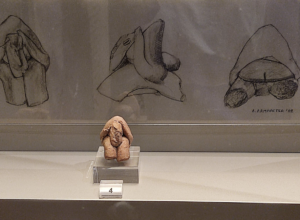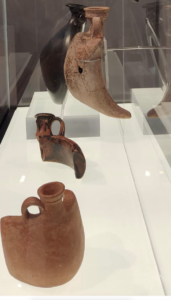Impressions from a guided tour at the National Archeological Museum of Athens
The tour was about the healers in Ancient Greece, their methods and tools they used for healing from pre-historical times until the end of the ancient world. At least that was my impression because at the end of the tour I was left with so many thoughts and questions about healing and the therapeutic relationship.
When I arrived the guide had already started the tour and showed us small idols from the neo-lithic times depicting the form of a woman that looks as if she has her head in her lap. He said it was possibly some form of deformity, although it was really hard to know exact information due to the amount of time that has passed and the lack of other information. The assumption of the archeologists is that the woman that is possibly old aged.
 Another idol shows a woman with a severe spinal deformity; such that makes her head look as if it is below her shoulder. The archaeologist commented on the fact that in this case a deformity of the body as well as old age was not a taboo and it seemed that this was something that the people at the time wanted to depict.
Another idol shows a woman with a severe spinal deformity; such that makes her head look as if it is below her shoulder. The archaeologist commented on the fact that in this case a deformity of the body as well as old age was not a taboo and it seemed that this was something that the people at the time wanted to depict.
The next part of the tour was about the Mycenean times. This term is applied to the art and culture of Greece from ca. 1600 to 1100 B.C. The name derives from the site of Mycenae in the Peloponnesos, where once stood a great fortified palace. There they found clay-made reports from the palace, which were preserved due to a fire solidifying the clay. The reports were about the tax system imposed at the time and the storage rooms of the palace. In these reports the names of certain people were mentioned that were listed as doctors. And certain substances used as medication were listed as inventory. The archaeologist said that at the time the profession of a doctor was recognised however there was also a strong belief that the healing process was due to supernatural forces and this was part of a traditional culture.
The next exhibit (feature picture above with the headline) was an impression in marble of Ulysses (King of Ithaca) return to Ithaca from Troy after a ten year effort. He arrived in Ithaca disguised as a beggar to plot against his enemies who were attempting to steal his wife and throne. The scene shows his governess, Eurykleia, washing his feet and recognising him from an old wound. The impression shows the contact between them – a very tender connection highlighted by Ulysses gesture of placing his hand to Eurykleia’s chin. His wife, Penelope, is behind them symbolising the house of Ulysses. This depiction of care over an old wound is a representation of a time when the care of wounds was important to maintaining health and that’s when Asclepius’s time starts.
Asclepius was a doctor believed to be a God, but possibly was an actual person. The myth said he was a son of Apollo (god of light and music among other things). He worked in Epidaurus and was later worshiped as a God. As a deity he never punished people, instead he was accepting of all people and all offers as requests for healing. The myth was that Zeus killed him because he started bringing humans back to life and that was his hubris. He is the last god of the ancient world to be worshiped even in Christian times (until the 8th century AD).
 As a rule in Ancient Greek art gods are depicted in carved reliefs larger than mortals. Asclepius had two sons, Machaon and Podalirius, who were both physicians and five daughters who had healing skills – Hygieia, Akeso, Iaso, Aegle and Panacea (Aegle and Hygieia are not depicted here). He is seen here holding his serpent entwined staff. The serpents symbolise the movement between this world and the world ‘under’ this world (world of death). It was believed that in order for someone to heal he would have to pass through the under world – through sleep – and return to this world. Asclepius was also considered the first to introduce reason into medical thinking.
As a rule in Ancient Greek art gods are depicted in carved reliefs larger than mortals. Asclepius had two sons, Machaon and Podalirius, who were both physicians and five daughters who had healing skills – Hygieia, Akeso, Iaso, Aegle and Panacea (Aegle and Hygieia are not depicted here). He is seen here holding his serpent entwined staff. The serpents symbolise the movement between this world and the world ‘under’ this world (world of death). It was believed that in order for someone to heal he would have to pass through the under world – through sleep – and return to this world. Asclepius was also considered the first to introduce reason into medical thinking.
 The next exhibit was the ancient hot water bottles that were discovered in the areas of Greece and Cyprus. They had different shapes and sizes, some have been found that have shapes of body parts (ears, genitals) and some to fit around specific joints. The large ones were probably for the abdominal area. They were filled with hot water or oil and contributed to the therapy of ailments, such as the common cold, arthritis, rheumatism, strained muscles and abdominal pain. The clay kept heat for a long time. The vases were from the 3rd century BC and AD. Some of them had names carved on them as if they were healing tools of a specific doctor and they were found in healing centres, taverns and tombs.
The next exhibit was the ancient hot water bottles that were discovered in the areas of Greece and Cyprus. They had different shapes and sizes, some have been found that have shapes of body parts (ears, genitals) and some to fit around specific joints. The large ones were probably for the abdominal area. They were filled with hot water or oil and contributed to the therapy of ailments, such as the common cold, arthritis, rheumatism, strained muscles and abdominal pain. The clay kept heat for a long time. The vases were from the 3rd century BC and AD. Some of them had names carved on them as if they were healing tools of a specific doctor and they were found in healing centres, taverns and tombs.
The final exhibit was the one that I found the most surprising. It was as decorative scene at the entrance of a temple of Asclepius (a healing place for those times). Among other things it shows a scene from the story of the Trojan war. One of the most violent ones, where the Greeks have invaded Troy and Homer (writer of the Iliad and the Odyssey) describes the ultimate violent act of genocide in such a detailed and shocking way. In this scene in particular the archeologists assume that one could see the King of Troy being dragged by the hair, women being chased and clashing with their enemies. Among all this violence and despair the King’s daughter, Cassandra, is seen reaching towards Athena’s statue and plead for help. However Cassandra according to the myth had prophetic power and she was informed by the Gods about this disaster. So this gesture of hers towards the godess Athena is a symbol that in times of crisis hope stands above knowledge. This is why the archeologists think that such a seen would be put as decoration at an Asclepius centre, where people would seek for help with their health problems and injuries.
I left the exhibition with many thoughts on the therapeutic relationship. Different aspects of such a relationship seemed to emerge from a different time, but it looks as if it was an important element. This made me wonder about how did the therapeutic relationship come to be as it is today? I thought that it would be interesting to try and bring forward how it has worked over time and how did our current perception of it come to be what is is today.

